Jōetsu Shinkansen
The Jōetsu Shinkansen (上越新幹線) is a high-speed shinkansen railway line connecting Tokyo and Niigata, Japan, via the Tōhoku Shinkansen, operated by the East Japan Railway Company (JR East). Despite its name, the line does not pass through the city of Joetsu or the historical Jōetsu region, which instead are served by the Hokuriku Shinkansen.
| Jōetsu Shinkansen | |||
|---|---|---|---|
 An E4 series train on a Joetsu Shinkansen Max Tanigawa service in March 2017 | |||
| Overview | |||
| Native name | 上越新幹線 | ||
| Type | Shinkansen | ||
| Locale | Tokyo; Saitama, Gunma, and Niigata Prefectures | ||
| Termini | Tokyo Niigata | ||
| Stations | 10 | ||
| Operation | |||
| Opened | 15 November 1982 | ||
| Owner | |||
| Operator(s) | |||
| Depot(s) | Niigata | ||
| Rolling stock | E2/E4/E7 series | ||
| Technical | |||
| Line length | 269.5 km (167.5 mi) | ||
| Track gauge | 1,435 mm (4 ft 8 1⁄2 in) | ||
| Electrification | 25 kV AC, 50 Hz, overhead catenary | ||
| Operating speed | 240 km/h (150 mph) (older rolling stock); 275 km/h (170 mph) (under construction) | ||
| |||
Train services
- Toki, Tokyo - Niigata (limited-stop)
- Max Toki, Tokyo - Niigata (limited-stop)
- Tanigawa, Tokyo - Echigo-Yuzawa (all-stations, since October 1997)
- Max Tanigawa, Tokyo - Echigo-Yuzawa (all-stations, since October 1997)
Stations
| Station name | Japanese | Distance (km) |
Transfers | Location | |
|---|---|---|---|---|---|
| Tokyo | 東京 | 0.0 |
|
Chiyoda | Tokyo |
| Ueno | 上野 | 3.6 |
|
Taitō | |
| Ōmiya | 大宮 | 31.3 |
|
Ōmiya-ku, Saitama | Saitama |
| Kumagaya | 熊谷 | 67.9 |
|
Kumagaya | |
| Honjō-Waseda | 本庄早稲田 | 88.0 | Honjō | ||
| Takasaki | 高崎 | 108.6 |
|
Takasaki | Gunma |
| Jōmō-Kōgen | 上毛高原 | 150.4 | Minakami | ||
| Echigo-Yuzawa | 越後湯沢 | 182.7 |
|
Yuzawa | Niigata |
| Urasa | 浦佐 | 212.3 | ■ Jōetsu Line | Minamiuonuma | |
| Nagaoka | 長岡 | 245.1 |
|
Nagaoka | |
| Tsubame-Sanjō | 燕三条 | 268.7 | ■ Yahiko Line | Sanjō | |
| Niigata | 新潟 | 300.8 |
|
Chūō-ku, Niigata | |
- Although the official terminus of the Ryōmō Line is at Shin-Maebashi and that of the Agatsuma Line is at Shibukawa, trains on both lines run through to Takasaki.
- Although the official terminus of the Joetsu Line is at Miyauchi, trains on the line run through to Nagaoka.
- Although the official terminus of the Ban'etsu West Line is at Niitsu, most trains on the line run through to Niigata.
The Gala-Yuzawa Line is a 1.8 km (1.1 mi) branch from Echigo-Yuzawa to Gala-Yuzawa Station. It operates in the winter months only, serving the adjoining ski resort.
Rolling stock
As of April 2017, the following train types operate on Joetsu Shinkansen services.
- E2 series: Toki / Tanigawa (since January 2013)[1]
- E4 series: Max Toki / Max Tanigawa (since October 1997)
- E7 series : Toki / Tanigawa (since March 3, 2019)
Between fiscal 2018 and 2020, eleven 12-car E7 series train sets are scheduled to be introduced on Joetsu Shinkansen services, replacing the E4 series trains,[2] raising the speed from 240 km/h to 275 km/h.[3]
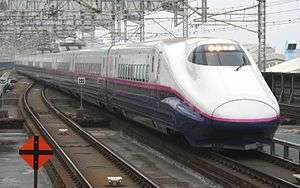 An E2 series trainset
An E2 series trainset- An E4 series trainset on a Max Toki service in January 2006
 An E7 series trainset
An E7 series trainset
Types no longer used
- 200 series: Toki / Tanigawa (until March 2013)
- E1 series: Max Asahi / Max Toki / Max Tanigawa (until September 2012)
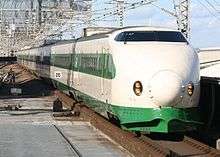 200 series on a Tanigawa service in January 2011
200 series on a Tanigawa service in January 2011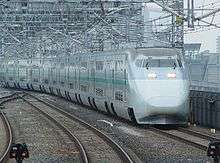 E1 series on a Max Asahi service in June 2002
E1 series on a Max Asahi service in June 2002
Speedup plans
The entire line is currently being upgraded to 275 km/h, with construction starting in May 2019. The upgrades are scheduled to be completed by 2023.[4]
This will mark the first time that an E7 series train has operated commercially at more than 260 km/h, which is the maximum speed of the only other line served by this train, the Hokuriku Shinkansen.
History
The program to build the new line was initiated in 1971 by Niigata-born prime minister Tanaka Kakuei; one popular anecdote is that Tanaka determined the line's routing by drawing it on a map with a red pencil.[5] Built at a cost of $6.3 billion,[6] it was built "to establish closer ties with Tokyo and promote regional development".[7]
Trial runs over the line began in November 1980, and regular service began on 15 November 1982. The line was initially planned to terminate at Shinjuku Station, but economic considerations pushed Japanese National Railways (JNR) to merge the line with the existing Tōhoku Shinkansen line at Ōmiya.
In September 1991, a 400 Series Shinkansen train set a Japanese rail speed record of 345 km/h (214 mph) on the Jōetsu Shinkansen line, and in December 1993, the STAR21 experimental train recorded 425 km/h (264 mph). The maximum speed for regular services on the line is 245 km/h (150 mph) except for the section between Jomo-Kogen and Urasa which is 275 km/h (170 mph) for E2 series trains travelling towards Niigata. The urban section between Tokyo and Ōmiya is 110 km/h (70 mph).[8]
The Basic Plan specifies that the Jōetsu Shinkansen should actually start from Shinjuku, which would necessitate building 30 km (19 mi) of additional Shinkansen track from Ōmiya. While some land acquisitions along the existing Saikyō Line were made, no construction ever started.
The Niigata prefectural government has proposed building a new multi-modal terminal to directly connect the Shinkansen to the port of Niigata, potentially allowing direct transfers to ferries and cruise ships, and to potentially allow direct access between the Shinkansen and Niigata Airport. However this plan is foreseen to be completed only by the mid-2040s.[9]
Special event train services
On 17 November 2012, a special Joetsu Shinkansen 30th Anniversary (上越新幹線開業30周年号, Jōetsu Shinkansen Kaigyō 30-shūnen-gō) service ran as Toki 395 from Omiya to Niigata using 10-car 200 series set K47.[10]
Also on 17 November 2012, a special Joetsu Shinkansen 30th Anniversary (上越新幹線開業30周年号, Jōetsu Shinkansen Kaigyō 30-shūnen-gō) service ran from Niigata to Tokyo using E5 series set U8, with a special ceremony at Niigata Station before departure.[11][12] This was the first revenue-earning service operated on the Joetsu Shinkansen by an E5 series trainset.[12]
See also
References
- E2系車両を上越新幹線に投入! [E2 series trains to be introduced on Joetsu Shinkansen] (PDF). News Release (in Japanese). Japan: East Japan Railway Company. 16 November 2012. Archived from the original (PDF) on 19 November 2012. Retrieved 16 November 2012.
- 上越新幹線へE7系投入 [E7 series to be introduced on Joetsu Shinkansen]. Tetsudo Hobidas (in Japanese). Japan: Neko Publishing. 4 April 2017. Archived from the original on 4 April 2017. Retrieved 4 April 2017.
- "JR East prepares for 275km/H operation on Joetsu Shinkansen". 2019-05-09.
- "上越新幹線スピードアップ工事に着手 最高速度275km/h、大宮~新潟間で7分程度短縮". 乗りものニュース (in Japanese). Retrieved 2019-05-08.
- "実に地球300周…雪国駆けた「丸顔の美人」 さらば新幹線200系". MSN Sankei News. 15 March 2013. Archived from the original on 1 February 2014. Retrieved 20 January 2014.
最後の活躍の舞台となった上越新幹線。その誕生には、田中角栄元首相が赤鉛筆で線を引きルートを決めたとの逸話も残る。
- Hayes, Louis D. Introduction to Japanese Politics, p.107.
- Takashima, Shuichi. Railway Operators in Japan 3: Tohoku and Niigata Region Archived 2008-11-20 at the Wayback Machine. Japan Railway & Transport Review No. 29 (pp.40–49)
- 300km/hのトップランナー [300 km/h Top Runners]. Japan Railfan Magazine. Vol. 52 no. 612. Japan: Kōyūsha Co., Ltd. April 2012. p. 14.
- 新潟の西港区に新幹線、 県が30年後構想. Nihon Keizai Shimbun. 16 April 2014. Retrieved 16 April 2014.
- "とき"395号「上越新幹線開業30周年記念号」運転 [Toki 395 "Joetsu Shinkansen 30th Anniversary"]. Japan Railfan Magazine Online (in Japanese). Japan: Koyusha Co., Ltd. 18 November 2012. Retrieved 18 November 2012.
- おかげさまで上越新幹線開業30周年 [Joetsu Shinkansen 30th Anniversary Celebrations] (PDF) (in Japanese). Japan: East Japan Railway Company, Niigata Division. 12 September 2012. Archived from the original (PDF) on September 20, 2012. Retrieved 15 September 2012.
- "団体臨時列車「上越新幹線開業30周年記念号」,E5系で運転" [Special "Joetsu Shinkansen 30th Anniversary" runs using E5 series]. Japan Railfan Magazine Online (in Japanese). Japan: Koyusha Co., Ltd. 18 November 2012. Retrieved 18 November 2012.
External links
| Wikimedia Commons has media related to Jōetsu Shinkansen. |
- JR East website (in Japanese)
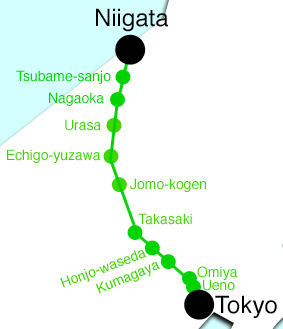
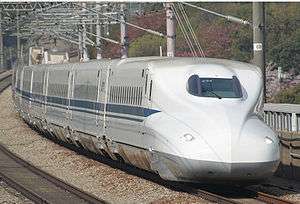
.svg.png)